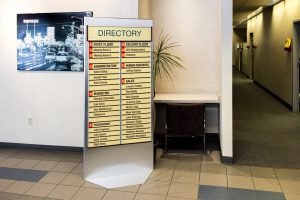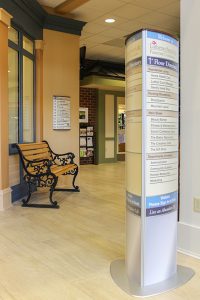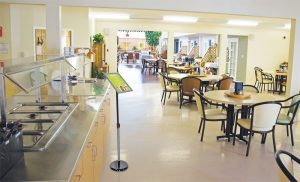 Interior directional signs, which are used to identify and guide, can take on many designs and forms, including freestanding, mounted, and post-and-panels.
Interior directional signs, which are used to identify and guide, can take on many designs and forms, including freestanding, mounted, and post-and-panels.
“Interior post-and-panels are used for a wide range of applications with some of the more common being wayfinding, informational/directories, tenant identification, point-of-purchase, or simply advertising,” says Stewart Curtis, president, Component Signage, Inc. (CSI). “Types of facilities that tend to utilize these the most are malls/retail, airports, schools/universities, medical facilities, and large corporate offices.”
Interior directional signs lend themselves well to large campuses or large corporate buildings where visitors depend on them for wayfinding. “Post-and-panel signs are most frequently used in lobbies and areas with a lot of foot traffic and are versatile enough to be included throughout a facility to direct visitors to various departments or divisions,” says Alex Frederick, marketing supervisor, Orbus Exhibit & Display Group.
These types of signs can also be used to hold literature, as interpretive displays showing information and history in places like museums and for displaying security or safety information.
According to Bill Freeman, vice president of Architectural Sales, and Jeffrey Stewart, vice president of Sales for Howard Industries, extruded aluminum, aluminum tubing frames, aluminum panels, and machined steel mounting plates are all commonly used in the creation of interior directional signs.
Curtis agrees. “Interior post-and-panels are most commonly made from extruded aluminum,” he says. “This allows for the best weight-to-strength ratio, along with a modular design [that] allows for changeability and mounting the post-and-panel in various locations. CSI’s modular interior post-and-panel systems can be fabricated with a weighted base so it freestands or base plates can be welded to the posts for bolting to the ground, wall, or ceiling.
 “In addition to aluminum being used, [we] commonly integrates composites into the aluminum structure of the post-and-panel,” says Curtis. “This can be done in the case of an illuminated sign where the sign face is acrylic or polycarbonate. Or if a light weight is a goal for the sign, aluminum panels can be substituted with aluminum composite panels. Dimensional graphics can also be achieved with acrylic or PVC composites.”
“In addition to aluminum being used, [we] commonly integrates composites into the aluminum structure of the post-and-panel,” says Curtis. “This can be done in the case of an illuminated sign where the sign face is acrylic or polycarbonate. Or if a light weight is a goal for the sign, aluminum panels can be substituted with aluminum composite panels. Dimensional graphics can also be achieved with acrylic or PVC composites.”
Orbus also recommends a combination of aluminum and other materials when fabricating interior directional signs—especially if they are freestanding versus mounted. “[If] these signs are freestanding, they require a certain durability,” says Frederick. “SignPro Systems, a division of Orbus Exhibit & Display Group®, utilizes a combination of heavy domed steel base plates, thermoformed black laminate tops and bottoms, along with aluminum extrusion accents and edging to give a sleek and modern look for its tower and sign stand displays.”
Designs on Display
These interior signs allow for creativity in shape and form beyond your typical posts-and-panel.
“The beauty of these wayfinding solutions is that they are built in such a way to let branding shine—the frame visually disappears,” says Frederick. “These are user-friendly and offer easily changed graphics whenever desired. SignPro Systems offers a number of different size and shape solutions to avoid custom building these displays, limiting the cost for the end-users.”
Howard Industries recommends one- to four-sided forms for interior directional signs, depending on the complexities and amount of the interior space available. “Three-sided seem to be the most popular,” say Freeman & Stewart. “Single- and double-sided systems with the attachment of changeable frames have been popular for directories and wayfinding scenarios, allowing for easy updates.”
The ability to easily update information is something sign shops should keep in mind, as the wayfinding and identification info displayed on these signs frequently needs to be changed.
“The best approach is to find a distributor partner that offers a comprehensive three-part system. Each wayfinding display solution includes a frame/post-and-panel system, a graphic, and a lens that can quickly and easily be removed for graphic replacements as needed,” says Frederick. “In addition to the wayfinding solutions, SignPro offers a number of sign stands or post-and-panel stands that have simple front-loading graphics to make change-outs a breeze.
Howard Industries works with inserts that are easily changed out. “By using the HID ‘paper insert’ technology, one can quickly and without special tools change out messages as needed with no disassembly required,” say Freeman & Stewart. “Acrylic signage is also able to be layered to form clear slider windows, allowing paper or other thin printable substrate to be slid in and out.”
CSI says that there are several common modular systems that allow for quick and easy changeouts. “CSI offers multiple systems where the individual panels are easily removed and replaced as the copy needs to change. This keeps the sign looking brand new over time instead of having to try and remove the old copy and use the same panel,” says Curtis.
Another system is a locking directory post-and-panel. “Many times, these are used with a corkboard backing where the media is very easily changed by unpinning the old insert and then pinning on the new information,” says Curtis. “This also allows the end-user to update the information with a normal computer and printer. These can also have a magnetized backer or a ‘paper gripper,’ both of which achieve ease of use for changing out the media. The added benefit with this locking cabinet system is it deters vandalism of the media inside.”
Enhancement Options
Shops can also look to dynamic digital signage as an option for easy and nearly endless customization of messaging.
Curtis notes that electronic message centers (EMCs) are being incorporated into interior sign designs more and more. “EMC units have come a long way and are now smaller and run cooler, which allows them to be integrated into sleeker post-and-panel cabinets,” he says. “As more manufacturers come into the EMC market, not only has the technology greatly increased, but the cost has significantly come down. Because of this, there has been an upward trend to integrate EMC units into post-and-panels, especially in interior applications. With the integration of phone apps and WiFi connectivity, changing the graphics on an EMC has [never] been easier for the end-user.”
Curtis remarks that LED lighting components have also improved interior post-and-panel sign design. “Illuminated post-and-panels have moved from the thicker and bulkier florescent illuminated cabinets of the past, to thinner cabinets that can be evenly illuminated with LEDs,” he says.
Location! Location! Location!
Aside from sign design, location is extremely important for interior directional signs.
“The first step to determining where wayfinding signage is needed is to put yourself in the mindset of the visitor or customer and walk in the front door,” recommends Frederick. “There is almost always signage needed in the lobby and by elevators and stairs because these are common junction points for all visitors. Any room throughout a facility that isn’t obvious or there are more than one of generally need signage, such as cafeterias, conference rooms, storage rooms, and business units/departments.”
Interior directional signs allow for multiple placement options. “The beauty of interior post-and-panels is that there are typically more options for where the sign can be mounted. Signs can be freestanding in the middle of a busy walkway, off to the side of a storefront, projecting off the side of a wall, or hanging from a ceiling,” says Curtis. “If a post-and-panel is located in a busy thoroughfare, it is recommended that the sign be bolted to the ground instead of being weighted down because of the obvious hazard of it being knocked over. Signs that back up to a wall or are in less busy areas can typically be weighted down, which allow for the sign in many cases to be moved around and repositioned easily.
“In the case the sign needs to display wayfinding or other information in a heavy foot traffic area, it can be best to bolt it from the ceiling, which allows the pedestrians to still easily view the sign, but at the same time the sign won’t be in the middle of the walkway.
“If a storefront wants to have their sign viewable from afar, then bolting the post-and-panel to the wall so that it projects outward allows the sign to be seen as the pedestrians make their way towards the store. This effectively gives the store more exposure in places like malls and airports where pedestrians are walking down long corridors.”
Freeman & Stewart recommend freestanding directional signs when ceiling or wall space is not available. “Often areas selected involve reception desk or lobby areas with high ceilings and no adjacent walls or hallways with more than one intersecting paths, like a four-way intersection,” they say. “Make sure the sign is visible, readable, color coordinated, and does not impede traffic or other messages.”
Sign shops themselves should be aware of traffic when installing these signs. “Be careful with affecting the normal business going on inside the building during installation,” say Freeman & Stewart.
If an install includes loud noises and is in areas where people are working, then it’s best to schedule work for off-hours or when the business is closed.
Also keep in mind any ADA guidelines for non-freestanding signage as well as location constraints so as not to make a sign too large, too small, or in the path of emergency exits, fire extinguishers, etc.
Sign shops should also be mindful of wear and tear that can occur from high-traffic areas. “Although weather is not a factor for indoor post-and-panel longevity, wear and tear can sometimes be worse for those located in areas where they are touched and bumped up against,” says Curtis. “[Be] conscious of the bottleneck areas and locate the signs in areas where they won’t be bumped into as easily.”
When relocating isn’t an option, look to build the signs from heavier duty materials or outfit them with bump guards.










